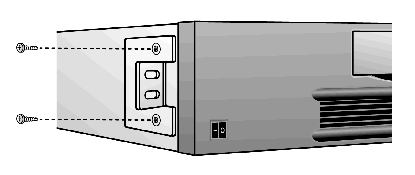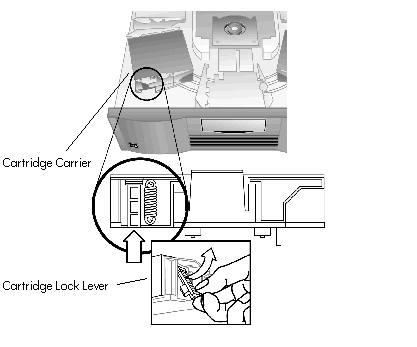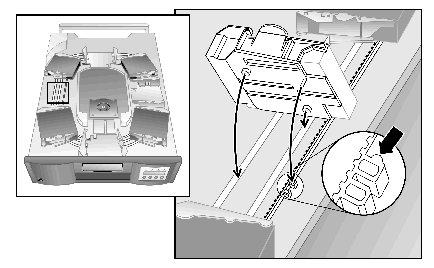Diagnostics and Troubleshooting: Dell™ PowerVault™ 122T LTO Autoloader
Troubleshooting
Installation Problems
Problems encountered during the installation of the autoloader are usually caused by improper SCSI bus configuration, application software configuration errors, or by an incorrectly configured operating system. If the application software that you are using is not communicating with the autoloader after installation, check the following:
-
SCSI ID: The autoloader occupies two SCSI IDs, one for the tape drive, and one for the autoloader robotics. Depending on other devices attached to the same SCSI bus and their SCSI IDs, you may need to change the SCSI ID of either the autoloader or tape drive before you can use the autoloader. Select an unused SCSI ID. See the manuals for the other devices on the SCSI bus or your operating system to determine which SCSI IDs are currently in use. If the autoloader is attached to a narrow (50-pin) SCSI bus (not recommended), only SCSI IDs 0 through 7 are available. See Changing the SCSI ID for instructions.
-
SCSI Cabling: Verify that all SCSI cables are securely connected at both ends. Check the length and integrity of your SCSI cabling. The total length of all cables connected to a SCSI bus must not exceed 19 feet (6 Meters) for a SCSI-1 SE bus, 10 feet (3 Meters) for a Fast SCSI (Narrow or Wide) or an Ultra SCSI (Narrow or Wide) SE bus, 40 feet (12 Meters) for an LVD bus with multiple devices, or 82 feet (25 Meters) for an LVD bus with a single device. The length of the internal SCSI cabling inside the autoloader is 2 feet (60 cm). This length must be included in any calculations of cable length. Try replacing suspect cables with known good cables. Note that it is not recommended to connect the autoloader to a narrow (50-pin) or Single Ended (SE) SCSI bus as performance will be restricted.
-
Termination: If the autoloader is the only SCSI device - other than the SCSI host adapter - on the selected SCSI bus, it must be terminated. Likewise, if the autoloader is physically the last SCSI device on the SCSI bus, it must be terminated. Only the devices physically at the beginning and end of the SCSI bus should be terminated. Refer to the manuals supplied with other devices on the SCSI bus for information on enabling or disabling termination on those devices.
To terminate the autoloader, locate the terminator in the accessories package and press it firmly into either of the two SCSI connectors on the rear panel of the autoloader. Secure the terminator by tightening the finger-screws until snug. The supplied terminator is "dual mode" and will work on both Low-Voltage Differential (LVD) and Single Ended (SE-not recommended) SCSI buses. A green LED on the terminator indicates that the unit is attached to a SCSI bus running in LVD mode. A red LED on the terminator indicates that the unit is attached to a SCSI bus running in SE mode. If the LED is not on, check all SCSI and power connections and confirm that the unit is attached to a valid SCSI bus.
-
Compatibility: Ensure that the autoloader and tape drive are compatible with the SCSI host adapter and backup application you plan to use. For a list of compatible SCSI adapters and application software, check with your SCSI host adapter manufacturer, backup application vendor, or the Dell support website at support.dell.com.
-
SCSI Host Adapter Installation: Verify that you have installed your SCSI host adapter correctly. Refer to the manual that came with your SCSI host adapter for installation and troubleshooting instructions. Pay particular attention to any steps describing the settings of various jumpers and/or switches on the host adapter, or on newer adapters, the setup application for the adapter. Make sure that the host adapter is properly seated in the motherboard slot and the operating system correctly detects the host adapter. Make sure that the proper device driver is installed for the SCSI host adapter.
-
Backup Application Installation: Refer to the documentation included with your backup application for instructions on how to verify proper installation. Most backup software packages require an additional module to communicate with the autoloader robotics.
-
Device Driver Installation: Make sure that the proper device driver, if applicable, is installed for both the autoloader and tape drive (See Installing the Device Drivers). Also refer to support.dell.com for more information. Note: Many backup applications use their own drivers for the autoloader and drive. Before installing a driver, make sure it will not be in conflict with the software.
Troubleshooting Table
|
Problem |
Solution |
|---|---|
| Power | |
|
Autoloader does not power on. |
|
|
No display messages appear. |
|
| Tape Movement | |
|
Tape stuck in drive. |
|
|
Tape stuck in storage slot. |
|
| Media | |
|
Cleaning or data cartridge incompatible with drive. |
|
|
Cannot write to or read from a tape. |
|
| SCSI ID | |
|
Changed drive or autoloader SCSI ID, but the host server does not recognize the new ID. |
|
| Autoloader Performance | |
|
The autoloader is not efficiently backing up data. |
|
| Cleaning | |
|
Recurring cleaning message. |
|
|
The Clean Drive LED is illuminated. |
|
|
Cannot load the cleaning cartridge. |
|
| Media Compatibility | |
|
Media format invalid for drive type. |
|
|
Media is rejected by the tape drive. Restore from tape NOT successful. |
|
| Media Attention LED Issues | |
|
Contamination by loose debris. |
|
|
Contamination by head staining. |
|
|
Non-acclimated media |
|
|
Wrong cleaning cartridge |
|
|
Bad/defective/contaminated media |
|
|
Expired cleaning cartridge |
|
| Errors Displayed on Front Panel | |
|
"!" in autoloader operator panel inventory display |
|
|
There is an error code on the LCD display |
|
Removing Stuck Cartridges
If the autoloader experiences a severe mechanical problem or if you need to remove cartridges because of a power failure or other circumstance in which the autoloader is unable to export the cartridges in the carousel, follow these steps:
| NOTE: Contact your Dell support representative if a cartridge is stuck in the drive. |
-
Move the power switch on the front panel to the OFF position.
-
Remove the power cable and SCSI cables from their connectors on the back panel of the autoloader.

CAUTION: To prevent injury, disconnect the power and SCSI cables before removing the autoloader cover and keep fingers away from the fan. -
Remove the autoloader from its rack slot, if applicable, and place it on a table or other clear work surface.
-
Use a screwdriver to remove the front cover screws that secure the mounting brackets (If the Autoloader is Rackmounted) from both sides of the autoloader.
Removing Mounting Brackets (Left Side Shown)

Remove the five screws on the back of the autoloader, and two additional screws, one on each side of the autoloader, to loosen the autoloader cover.
Remove Indicated Back Cover Screws Only

-
Remove the top cover by lifting it from the back and easing it out from under the front panel display cover.
-
Lift the cartridge carrier, with each cartridge you want to remove, straight up from the autoloader.

NOTE: To remove the carrier directly in front of the Import/Export slot, gently rotate the carousel counterclockwise by moving the belt or carriers until the carrier is no longer in front of the Import/Export slot. -
On each carrier, carefully pull the cartridge lock lever away from the carrier, allowing the cartridge to slide out of the carrier.
Pull Cartridge Release Lever

-
After removing the cartridges from the desired carriers, reinstall each carrier on the autoloader belt (See Installing the Carrier Below.).
-
Make sure that the rollers on the bottom of the carrier are aligned in the carrier tracks.
-
Make sure that the belt post beneath each carrier are inserted into the proper autoloader belt loop.

NOTE: There are unused loops on the belt. The proper belt loops have an extra bump on the outside of the loop. See Installing the Carrier below.
Installing the Carrier

-
Ensure the carrier is properly installed on the belt by gently pressing on the top of the carrier and sliding it back and forth. If it is properly attached to the belt, it should not move. If it does, reinstall the carrier.
-
Replace the top cover of the autoloader and reinstall the cover screws and mounting brackets (If Rack Mounted).
Autoloader Error Codes
If an error occurs during operation of the autoloader, the autoloader stops the current operation and displays an error code on the top line of the LCD screen. Unless otherwise noted in Autoloader Error Codes., attempt to resolve the error by resetting or cycling power on the autoloader and retrying the last operation. If the error persists, contact support personnel.
To view the error log follow these steps:
-
From the Home Screen or main menu, press the [+] or [-] button until Information appears on the top line of the LCD screen.
-
Press the [Enter] button to access the available options.
-
Press the [+] or [-] button until View Error Log appears on the LCD screen. The LCD screen also displays the quantity of errors and events currently stored in the error log.
-
Press the [Enter] button to access the most recently logged error message.
-
Press the [+] or [-] button to display each error in the log.
-
Press [Cancel] when done.
A description of each of the error codes is provided in the following table:
| NOTE: Error codes displayed on the front panel LCD during normal operation, as opposed to when viewing them through the event log, will not display the preceding '3' and '0' characters, included in the table below. Also note that when viewing the event log, error codes must be preceded by the '3' and '0' characters to be considered valid. |
Error Codes
|
Error Code |
Description |
Details |
|---|---|---|
3 0 81 |
Invalid Command Error. |
This error indicates that the autoloader received an undefined command or an invalid parameter with a command. |
3 0 82 |
Device Status Not Suitable to Execute This Command. |
If the robotics are busy, some commands cannot be executed at the same time. This error indicates a probable violation. This is not an error condition, but does result in busy being reported to the host for the requested SCSI command. |
3 0 83 |
Inventory Not Valid. |
The cartridge inventory is not valid because of manual changes or previous fatal errors. Update the inventory using the Re-inventory option in the Configuration menu. See Creating an Inventory of Cartridges or power cycle. |
3 0 84 |
Source Empty. |
There is no cartridge in the location from which a cartridge move was issued. |
3 0 85 |
Destination Full. |
The location to which a cartridge move was issued already contains a cartridge. |
3 0 86 |
Import/Export Slot Access Rejected. |
User attempted to access the Import/Export slot, but media removal was prevented by the host. |
3 0 87 |
Operation Timeout. |
A command did not complete in the required amount of time. |
3 0 88 |
Communications Error During Loop-Back. |
Cycle power on the autoloader and attempt the operation again. If the error recurs, contact your technical support representative. |
3 0 89 |
System Test Timeout. |
There was a communication timeout between the drive and loader during the System Test. |
3 0 8F |
Recovered Loader Error. |
Loader error recovery successful. Your diagnostic tool can provide details of the original loader error. |
3 0 90 |
Mechanical Initialization Failure. |
The robotics were not able to move to the safe mechanical initialization position. Manual intervention is necessary. |
3 0 91 |
Inventory Scan Failure. |
Fatal robotic error occurred during the inventory scan. |
3 0 92 |
Preposition Failed. |
Belt positioning error occurred during 'Preposition' command. |
3 0 93 |
Cartridge Load Error. |
A failure occurred while trying to load a cartridge a slot to the drive. |
3 0 94 |
Cartridge Unload Error. |
A failure occurred while trying to unload a cartridge from the drive to its slot. |
3 0 95 |
Import Error. |
An error occurred while trying to import a data cartridge to a carousel slot. |
3 0 96 |
Export Error. |
An error occurred while trying to export a data cartridge from its carousel slot. Can be caused by an empty slot that is expected to be full. |
3 0 A0 |
Carousel Motion Failure. |
Error occurred during carousel movement (Position Not Found). Could be caused by a missing or misaligned cartridge carrier, or an obstruction, or unexpected cartridge in either the carousel path or Import/Export slot. |
3 0 A1 |
Cartridge Transport Position Error. |
Cartridge transport element is unable to reach its desired position. Failure occurred while trying to place a cartridge into or remove a cartridge from the drive or a slot. |
3 0 A2 |
Gripper Position Error. |
Gripper unable to reach position. |
3 0 A3 |
Cartridge Pick Error. |
Error occurred while trying to pull a cartridge from the drive or a carousel slot. |
3 0 A4 |
Import/Export Slot Position Error. |
The Import/Export slot door was not in the requested position during device operation. Can be caused by manually opening the door or a cartridge or other obstruction is blocking the door. Try removing the cartridge or obstruction, then power cycle or reset the autoloader. |
3 0 A5 |
Fan Error. |
Autoloader Processor Detected a Fan Error. |
3 0 B0 |
ROM Error. |
Cycle power on the autoloader and attempt the operation again. If the error recurs, contact your technical support representative. |
3 0 B1 |
RAM Error. |
Cycle power on the autoloader and attempt the operation again. If the error recurs, contact your technical support representative. |
3 0 B2 |
NVRAM Error. |
Cycle power on the autoloader and attempt the operation again. If the error recurs, contact your technical support representative. |
3 0 B3 |
Controller Timer Failure. |
An unrecoverable failure has occurred in the controller timer circuit. |
3 0 B4 |
Loader To Drive Communication IC Error. |
Failure in IC handling loader to drive communication. |
3 0 B5 |
Display Error. |
Cycle power on the autoloader and attempt the operation again. If the error recurs, contact your technical support representative. |
3 0 B6 |
Memory Error. |
Cycle power on the autoloader and attempt the operation again. If the error recurs, contact your technical support representative. |
3 0 B7 |
Timeout on Autoloader Command |
Cycle power on the autoloader and attempt the operation again. If the error recurs, contact your technical support representative. |
3 0 BC |
Drive Bug-Checked. |
Cycle power on the autoloader and attempt the operation again. If the error recurs, contact your technical support representative. |
3 0 BF |
Fatal Error. |
Cycle power on the autoloader and attempt the operation again. If the error recurs, contact your technical support representative. |